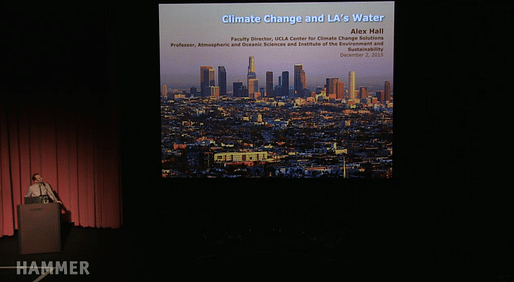

Last week, UCLA’s Hammer Museum hosted the final iteration of its 2015 program "Next Wave: Quality, Quantity, and Accessibility of Water in the 21st Century," a robust discussion series that has gathered experts in various fields to explicate and consider the most pressing issues surrounding water in the 21st century. This final event, subtitled "Thriving in a Hotter Los Angeles," grappled with issues closest to home, largely under the purview of the goals articulated by the ambitious "Sustainable LA Grand Challenge," a UCLA initiative dedicated to achieving water and energy sustainability in the county by 2020.
Claudia Bestor, the director of public programs at the Hammer, began the evening by introducing the speakers: Mark Gold, Associate Vice Chancellor for Environment and Sustainability (among other titles) at the Institute of the Environment and Sustainability, UCLA; Alex Hall, the faculty director at the UCLA Center for Climate Change Solutions; Eric Hoek, the founder and CEO of Water Planet, Inc. and a professor (currently on leave) of engineering at UCLA; and Liz Croon, the Water Policy Advisor for the Office of Mayor Eric Garcetti. 
According to Bestor, this is “a group of people using their collaborative brain power to survive and even thrive in the face of increasing temperatures and drought." Their overarching goal is for Los Angeles to having a 100% local water supply in the future.
Each participant gave a short survey of the issues most relevant to their area of expertise before they sat down for a panel and answered audience questions. Gold, who was also the moderator of the panel, was the first to speak and provided essential facts that contextualized the larger conversation:


"Just realize, it's not technology that's the biggest hold up," Gold stated, articulating a sentiment that was repeated throughout the evening. "It's probably governance."
Alex Hall followed, discussing the local and regional implications that can be expected of global warming.
“The Sierra Nevada snowpack is an especially important resource in our current water management regime," Hall began. "It acts as a natural reservoir, storing water as snow and ice until it gradually melts throughout the spring and into summer.”
Currently, the Sierra Nevada snowpack provides about 60% of the region's water, but it's a resource highly vulnerable to climate change. Hall explained that under a "business as usual" scenario, we can expect that more than half of the volume of the snowpack will be lost by the end of the century. Even if greenhouse gas emissions are reduced, significant loss will be essentially inevitable.

One of the main reasons for such a significant loss is the "snow-albedo feedback cycle," in which loss of snow cover contributes to increased local warming as the exposed land absorbs more solar radiation. In turn, this leads to greater snow loss. Additionally, global warming will lead to more precipitation as rain rather than snow, overtaxing infrastructure like dams. In short: "non-local resource is really at risk, and it will become more and more expensive as we continue to rely on it.”
But rainfall in the local region, on the other hand, will likely be consistent despite temperature increases, even if it appears more often in the form of extreme weather events that are more and more variable. With that in mind, higher temperatures also result in increased demand for water, and evaporation rates increase exponentially.
With these phenomena in mind, Hall stated that it was unlikely we could hope to rely on Sierra Nevada snowpacks, and rather called for more stormwater capture, as well as the priorities underlying how we use the water we have.


Eric Hoek went on next, describing himself as "the technology guy." He enumerated the complex relationships between energy production and water use (the energy-water nexus), asking, “How do we enable water technology to exist and be useful while maybe conserving some energy in the process?”
Hoek and his collaborators have pioneered the invention and development of new technologies to this end. Notably, they created a new type of reverse-osmosis membrane that greatly improves the efficiency of desalination.
Hoek also touched on the "energy-water-food nexus," such as the fact that about two-thirds of water is devoted just for irrigation, and that 80% of water consumption world-wide is for food production. He advocated for employing advanced technologies to greatly reduce energy and water usage in agriculture, through indoor, efficient farming.
Liz Croon, the first-ever water policy advisor for the Mayor's Office, was the final panelist to speak. Croon outlined the City's current initiatives, in particular the Sustainable City Plan, which she called "a very comprehensive roadmap to how we get to both shorter and long-term goals.”
She noted existing initiatives that have been successful, such as rebates for homeowners to replace lawns with native plants and to install cisterns. At the same time, she acknowledged difficulties, such as the potential to lose momentum as the heavy rains of the impending El Niño may make people lose sight of the overarching reality of the drought.
For Croon, the path to 100% local water and sustainable resource use must involve issues pertaining to economics and social equity alongside the ecological questions. “There’s challenges, but there’s also a lot of potential," she stated.
To watch the full video, or listen to the Q+A, visit the Hammer Museum's website here.
No Comments
Block this user
Are you sure you want to block this user and hide all related comments throughout the site?
Archinect
This is your first comment on Archinect. Your comment will be visible once approved.